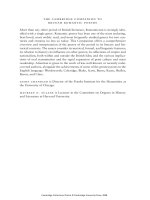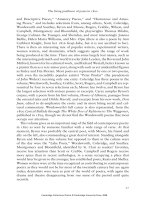The cambridge companion to british roman 43
Bạn đang xem bản rút gọn của tài liệu. Xem và tải ngay bản đầy đủ của tài liệu tại đây (38.57 KB, 1 trang )
The living pantheon of poets in 1820
and Descriptive Pieces,” “Amatory Pieces,” and “Humorous and Amusing Pieces,” and includes selections from, among others, Scott, Coleridge,
Wordsworth and Southey, Byron and Moore, Rogers, Crabbe, Wilson, and
Campbell, Montgomery and Bloomfield, the playwrights Thomas Dibdin,
George Colman the Younger, and Sheridan, and most interestingly Joanna
Baillie, Helen Maria Williams, and Mrs. Opie (there is also a poem by Ann
Cuthbert Knight, from her 1816 Keep-Sake, but it is not ascribed to her).
There is then an interesting mix of popular writers, experimental writers,
women writers, and dramatists, which suggests again the range of work
being produced at the time. There are also some largely lost names, such as
the interesting polymath and world traveler John Leyden, the Reverend John
Mitford, known for his editorial work, and Richard Westall, better known as
a painter than as a very minor poet, along with such as yet unidentified figures
as Finley and Fitz-Florian. Most poets are represented by one or two poems,
with even the incredibly popular satirist “Peter Pindar” (the pseudonym
of John Wolcot) receiving only one entry. Coleridge has three poems in the
volume; Wordsworth, Southey, Crabbe, Scott, Rogers, and Campbell are represented by four to seven selections each; Moore has twelve; and Byron has
the largest selection with sixteen poems or excerpts. Carey samples Byron’s
corpus, with a poem from his first volume, Hours of Idleness, passages from
the oriental tales and Childe Harold, and excerpts from his new work, Don
Juan, edited to de-emphasize the erotic and its most biting social and cultural commentary. Wordsworth’s full career is also represented, from the
1800 Lyrical Ballads through The White Doe of Rylstone to The Waggoner,
published in 1819, though we do not find the Wordsworth poems that most
occupy our attention.
This volume gives us an important map of the field of contemporary poetry
in 1820 as seen by someone familiar with a wide range of verse. At that
moment, Byron was probably the central poet, with Moore, his friend and
ally on the left, also commanding a great deal of interest. Standing alongside
Byron and Moore in this volume but opposed to them in the culture wars
of the day were the “Lake Poets,” Wordsworth, Coleridge, and Southey.
Montgomery and Bloomfield, identified by St. Clair as readers’ favorites,
receive less attention than Scott or Crabbe. Campbell and Rogers receive
more space than in recent anthologies, in a sense occupying a place that
would later be given to the younger, less established poets, Keats and Shelley.
Women writers were at the time recognized as contributing to contemporary
poetry as they would not be for most of the twentieth century but are again
today; dramatists were seen as part of the world of poetry, with again the
drama and theatre disappearing from our sense of the period until quite
recently.
21
Cambridge Collections Online © Cambridge University Press, 2008









